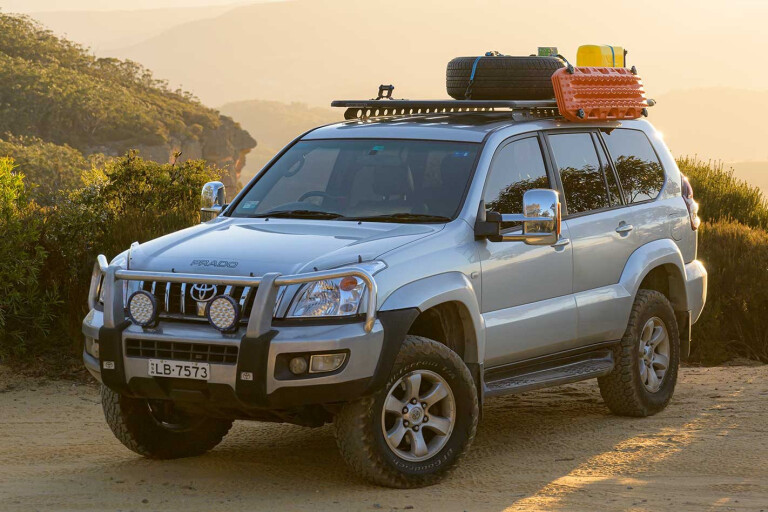
At 4X4 Australia we want our roof racks to do everything and then some more, so we’ve been keeping an eye on low-profile roof platforms as they’ve progressed from welded steel to alloy to composite with present-day systems offering an accessory list longer than your mate’s rusting winch cable.
The idea behind these nifty rooftop trays is they should be just as at home halfway across the Tanami as they are dodging the sprinkler system of your local undercover carpark. They should brace a mountain bike for Friday arvo rides with mates or a kayak for a spot of estuary fishing, but also tote a spare wheel and high-lift jack for those off-road exploratory camping sojourns. It needs to offer simple attachment and removal of accessories, even a roof box … and of course be relatively easy to fit, quiet, aerodynamic and look sleek but tough.
A tall ask, but if you’re forking out more than $1.5K for some powder-coated aluminium to bolt to our roof, it’s gotta be better than some rusting tradie-bars and a couple of frayed bungees.
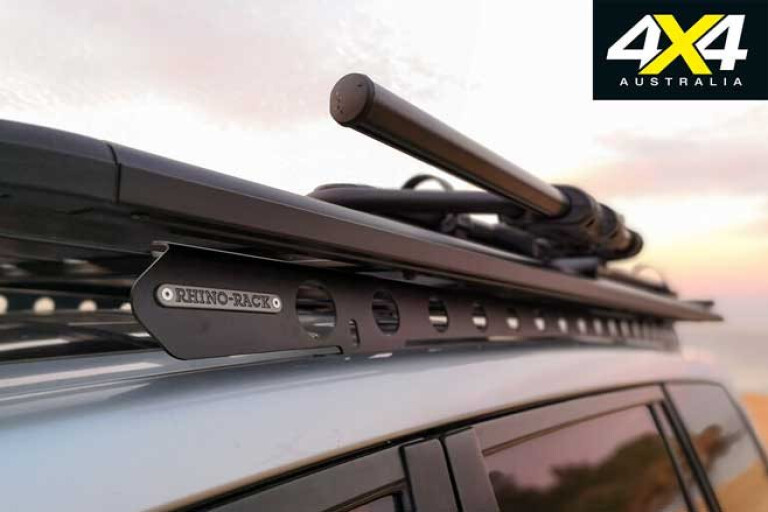
In Rhino’s favour is the fact it has been manufacturing roof racks since Richard Cropley developed the first prototype in 1992. The Pioneer system emerged in 2010 and has been refined over the last decade with the present-day iteration made from non-corrosive reinforced nylon and aluminium, delivering an extremely lightweight but durable product.
For our review we opted for Rhino’s 2128mm x 1236mm Pioneer Platform coupled with a Rhino-Rack Backbone to replace the Prado 120 Grande’s existing factory roof rails. This combination provides us with the lowest possible profile and max load capacity for our vehicle. In fact, when fitted via the Prado’s existing ditch mounts, the backbone sits at the exact same 50mm midpoint-ditch-mount roof clearance as the Toyota factory rail.
With our Pioneer Platform installed atop the backbone, the overall vehicle height is increased by 90mm at the midpoint, a mere 40mm over the original roof rails (without accessories), delivering one of the market’s lowest profile offerings.
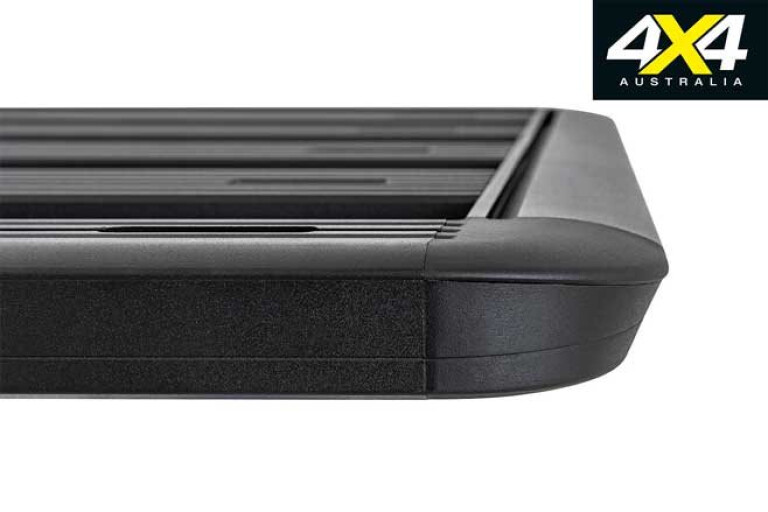
For the Prado fit-out, the backbone and Pioneer Platform deliver a maximum on-road vehicle allowance of 120kg, while offering a staggering static roof allowance of 360kg and off-road allowance of 96kg. This adds an extra 20kg allowance from the factory rail’s on-road allowance of 100kg.
Additionally, the Rhino-Rack Backbone has been tested to International Standards ISO PAS 11154-2006 Road Roof Load Carriers and Australian Standards AS1235-2000 Road Vehicle Roof Bar Testing, which is important for both insurance and safety purposes.
For those who want a simpler installation and aren’t as concerned with vehicle clearance and load capacity, Rhino-Rack’s Heavy Duty Removable Rail Mount CXB or SX legs fit directly to factory rails. When combined with the platform itself, however, this combination on the Prado sits nearly 40mm higher than the backbone mount (without accessories) while also limiting the platform’s on-road cargo capacity to under 75kg.
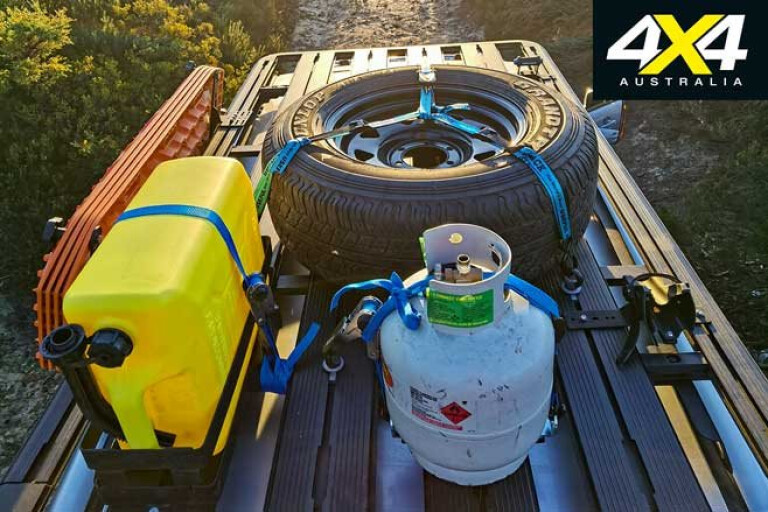
Installation is reasonably straightforward and Rhino-Rack offers clear and concise instructions with detailed diagrams for every product so fitting can be carried out at home with a mate and a good set of tools, but you’ll need to be patient and precise when fixing the backbone channel-nuts to the platform. The 2020 platform (now available) with an integrated measuring strip makes things easier on this front.
With a backbone and platform installed, the roof becomes a base for your next adventure, and for our 4x4 setup we chose a Spare Wheel Holder, Gas Bottle Holder (4kg), Horizontal Jerry Can Holder and Recovery Track Holder to fix our tools. For fixing toys, we installed a bike mount, kayak mount and roof box option as well as a Pioneer Roller and a load of eyebolts.
Bicycle

For the bike we trialed both the new Thru Axle Bike Carrier and the existing Hybrid Bike Carrier. The Thru Axle offers a simple low-profile design that keeps your bike sturdily in place. The cons however are the need to remove and find a place for the front wheel and the need to purchase the appropriate Thru Axle insert for varying axle diameters. Once setup though, it is a breeze to use.
The Hybrid Bike Carrier on the other hand is a beast of a bracket and requires quite a bit of finicky installation to fit to the Pioneer platform (which was accentuated when our Whispbar bike carrier secured tool-free in seconds). After initial installation however the Hybrid Bike Carrier is easy to use, sturdy and secure and has ability to accept a host of different bikes, all lockable in place with the integrated locks and without removing any wheels.
Snow Gear
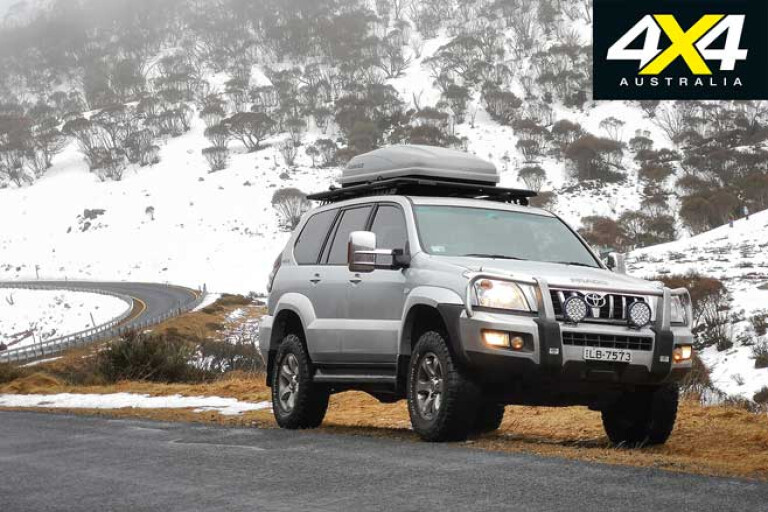
For the snow we opted to use our existing Rhino Masterfit 440 Roof Box. We’ve had this for a number of years and it has been on multiple outings without missing a beat. The ABS/ASA thermoplastic roof box is lightweight and easy to install with tool-free brackets clamping firmly to most roof racks, or in this case the Accessory Bars. Our small complaint with the roof box is any equipment packed against the side of the box can obstruct the internally exposed locking mechanism forcing some last-minute gear manipulation to get it to.
Kayaks

For our kayak we chose to go with the tried and trusted Nautic 581 Rear Loading Kayak Carrier. This allowed us to fix our 5m, 30kg Dagger 6.10 Exodus Sea Kayak to the roof of the Prado. It’s a hefty kayak to haul atop a 4x4 and after a few outings we opted to install the Pioneer Roller.
Fixed in mere minutes to the rear of the Pioneer tray, the roller allows our kayak to roll onto the Nautic brackets where it can then be settled to sit flush and fixed securely. The Nautic system is tool-free with the only downside being it can be difficult to tighten the turn-wheel brackets enough to accommodate a heavy sea kayak and can be hard to undo. All-in-all the system works as it should.
Verdict
The Rhino-Rack Backbone and Pioneer Platform combination comfortably delivers on what it has been designed for. It is low-profile, rugged and hard wearing, with a high build quality. The platform is quiet on road, looks stylish and most importantly offers a plethora of options for everything from trade to 4x4 to adventure accessories.
The Pioneer Platform loses some points for small frustrations such as limited tool-free options, the need for a multitude of tools to fit accessories, and design issues surrounding the use of accessory bars.
Fortunately, and perhaps unsurprisingly, the practicalities of the platform far outweigh its minor annoyances and when, on occasion, we found ourselves scratching our heads in frustration, we were relieved to discover the Pioneer Platform is as much about practicality as it is about prettiness.
All-in-all, the Rhino-Rack Pioneer Platform does exactly what is asked of it, performs admirably and delivers an extremely capable roof-carrying system for those who demand a solid tray to excel in the harshest of Australian conditions.

COMMENTS